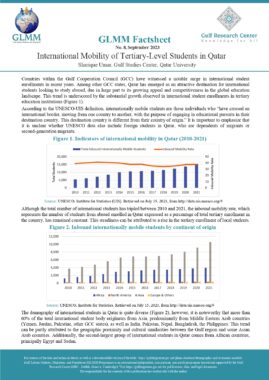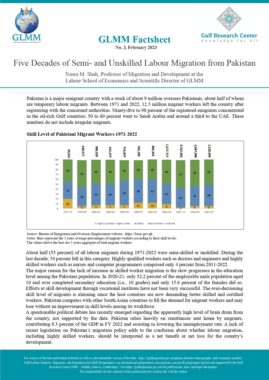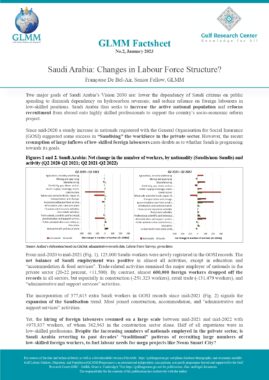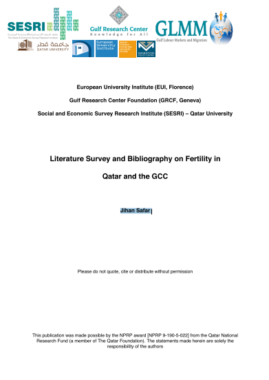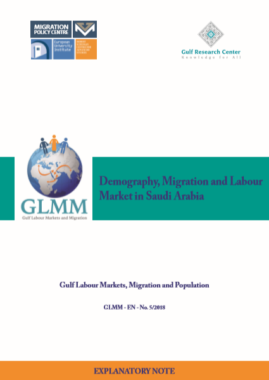Unemployed population aged 15 and above by nationality (Qatari/ non-Qatari), sex and age group (2013)
| Qatari | Non-Qatari | Total | |||||||
| Males | Females | Total | Males | Females | Total | Males | Females | Total | |
| 15 – 19 | 17 | 125 | 142 | 133 | 106 | 239 | 150 | 231 | 381 |
| 20 – 24 | 108 | 486 | 594 | 417 | 712 | 1,129 | 525 | 1,198 | 1,723 |
| 25 – 29 | 135 | 171 | 306 | 146 | 504 | 650 | 281 | 675 | 956 |
| 30 – 34 | 103 | 63 | 166 | 97 | 164 | 261 | 200 | 227 | 427 |
| 35 – 39 | 16 | 125 | 141 | 0 | 161 | 161 | 16 | 286 | 302 |
| 40 – 44 | 21 | 25 | 46 | 0 | 164 | 164 | 21 | 189 | 210 |
| 45 – 49 | 0 | 34 | 34 | 0 | 92 | 92 | 0 | 126 | 126 |
| Total | 400 | 1,029 | 1,429 | 793 | 1,903 | 2,696 | 1,193 | 2,932 | 4,125 |
Source: QSA, Ministry of Development Planning and Statistics
ANNEXED NOTE
1. Technical Notes and Definitions
The data is taken from 2013 Labour Force Survey (yearly synthesis)
Sampling frame of LFS 2013: Population Census 2010.
Sample size: 8,342 households and 55,771 individuals from: 1- Qatari households; 2- Non-Qatari regular (non-collective) households; 3- Non-Qatari small collective households (2 – 6 persons); 4- Non-Qatari large collective households (7 persons or more).
Data Collection: The sample was divided into equal parts to collect data monthly. Each month 1/3 of the quarterly data were collected during the first two weeks of the month.
Reference period for the labour force data: the week prior to data collection day.
Population of reference: all Qatari and non-Qatari households present in Qatar on the night of survey, living in normal and collective households.
The collective households are a group of persons not related to each other and sharing living conditions in a residential unit, I.e. labour camps, students living boarding schools, nurses in hospitals… etc. The survey covered the small collective households (includes less than 7 persons) and large collective households (includes 7 persons or more).
The survey did not cover short periods accommodation, i.e. hotels.
The data refers to the unemployed population, i.e.:
All persons aged 15 years and over who were, during the week preceding the survey, without employment, willing to work and looking seriously for a job.
a) First time unemployed: They are the persons who never worked previously, and were during the week preceding the survey looking actively for work.
b) Unemployed who previously worked: They are the persons with a work experience, who during the week preceding the survey were actively looking for a job
2. Institution which provides data
Qatar Statistics Authority (QSA), Ministry of Development Planning and Statistics
(http://www.qsa.gov.qa/eng/index.htm for website in English; http://www.qsa.gov.qa/Ar/index.htm for website in Arabic)
3. Data availability
The Statistics Authority conducted the first labour Force Sample Survey in 2001. Starting from 2006, the execution of these surveys came to be on annual basis. Quarterly publications of Labour Force Surveys’ data are also available since 2012.
Most Labour Force Surveys and publications related to the labour force are available on QSA’s website, in PDF format. LFS 2013 can be downloaded from:
https://www.mdps.gov.qa/en/statistics1/pages/topicslisting.aspx?parent=Social&child=LaborForce
See also Qatar Information Exchange for earlier Labour Force Surveys. QIX has also an interactive data base compiling data on the labour force taken from available surveys:
http://www.qix.gov.qa/portal/page/portal/qix/subject_area/Statistics?subject_area=183
Similar Posts:
- Unemployed population aged 15 and above by nationality (Qatari/ non-Qatari), sex and education level (2013)
- Unemployed population aged 15 and above by nationality (Qatari/ non-Qatari), sex and job history (2013)
- Qatar: Economically active population aged 15 and above by nationality (Qatari/ non-Qatari), sex and age group (2017)
- Unemployed population (15 years and above) by nationality (Qatari/ non-Qatari), sex and age group (2012)
- Qatar: Economically active population aged 15 and above by nationality (Qatari/ non-Qatari), sex and employment status (2017)
Tags: Education, Labour Market, Qatar, Unemployment

































